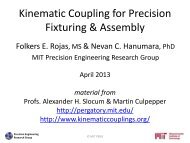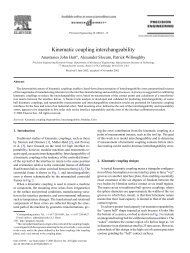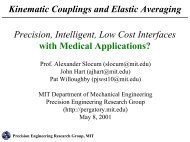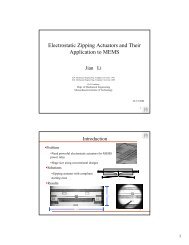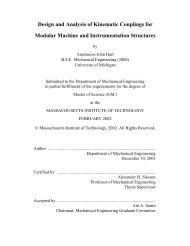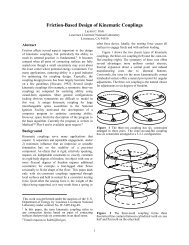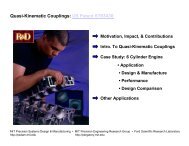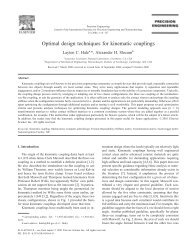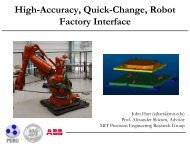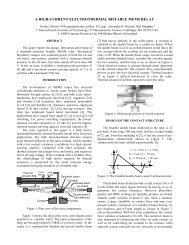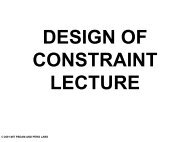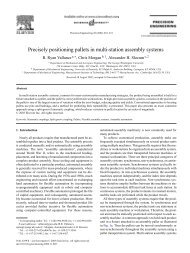Design of a Hybrid Positioner-Fixture for Six-axis Nanopositioning ...
Design of a Hybrid Positioner-Fixture for Six-axis Nanopositioning ...
Design of a Hybrid Positioner-Fixture for Six-axis Nanopositioning ...
Create successful ePaper yourself
Turn your PDF publications into a flip-book with our unique Google optimized e-Paper software.
<strong>Design</strong> <strong>of</strong> a <strong>Hybrid</strong> <strong>Positioner</strong>-<strong>Fixture</strong> <strong>for</strong> <strong>Six</strong>-<strong>axis</strong> <strong>Nanopositioning</strong> and Precision FixturingSubmitted to Precision EngineeringLRAShaftLALAFigure 2: Moving groove (left) and eccentric ball (right) HPF designs. LA = linear actuator and LRA =linear-rotary actuatorIn this paper, we investigate an alternate six-<strong>axis</strong> design in which the balls are rigidly attached to theirrespective component while the groove surfaces are actively positioned. This arrangement is shown onthe left side <strong>of</strong> Fig. 2. In this design, the groove surfaces are mounted to bearings which guide themparallel to the plane <strong>of</strong> coupling and perpendicular to the groove’s plane <strong>of</strong> symmetry. At each ballgroovejoint, the in-plane and out-<strong>of</strong>-plane displacements <strong>of</strong> the ball-equipped (top) component withrespect to the groove-equipped component may be achieved as shown in Fig. 3.ez i ig i1 g i2g i1 g i2Figure 3: Groove displacements which induce out-<strong>of</strong>-plane (left) and in-plane (right) displacements <strong>of</strong>the top componentEach i th ball-groove joint is there<strong>for</strong>e capable <strong>of</strong> two independent position inputs, g i1 and g i2 . If thegrooves are laid out to ensure linear independence <strong>of</strong> the groove constraints, the device will have sixindependent position inputs. When these inputs are changed <strong>for</strong> each joint, it becomes possible to controlthe position and orientation <strong>of</strong> the ball-equipped component in six DOF.3. Kinematic modelingIn this section, we discuss the approach used to model the positioning kinematics <strong>of</strong> the HPF.3.1. Relationship between actuator displacement and ball displacementIn this analysis, we treat the grooved component as grounded and the ball-equipped component as mobile.The change in position <strong>of</strong> the balled-component’s coupling centroid is defined by the changes in position<strong>of</strong> the ball centers. Equations 1 and 2 describe the relationship between ball displacement and groovedisplacement <strong>for</strong> ball i.4



